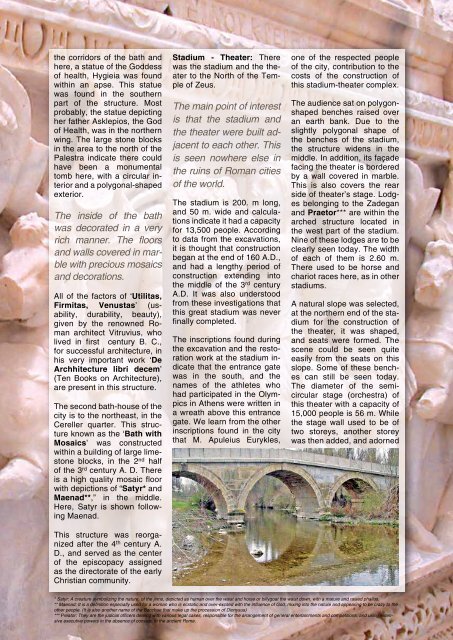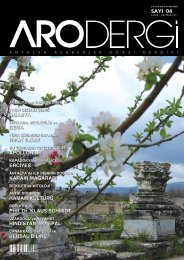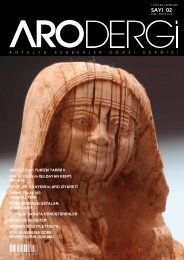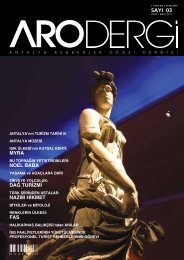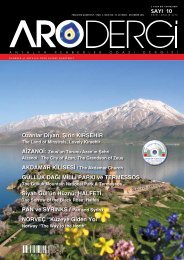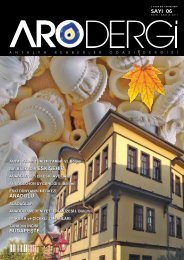Sayı 11- Ocak/Mart 2013 - Antalya Rehberler Odası
Sayı 11- Ocak/Mart 2013 - Antalya Rehberler Odası
Sayı 11- Ocak/Mart 2013 - Antalya Rehberler Odası
- No tags were found...
Create successful ePaper yourself
Turn your PDF publications into a flip-book with our unique Google optimized e-Paper software.
the corridors of the bath andhere, a statue of the Goddessof health, Hygieia was foundwithin an apse. This statuewas found in the southernpart of the structure. Mostprobably, the statue depictingher father Asklepios, the Godof Health, was in the northernwing. The large stone blocksin the area to the north of thePalestra indicate there couldhave been a monumentaltomb here, with a circular interiorand a polygonal-shapedexterior.The inside of the bathwas decorated in a veryrich manner. The floorsand walls covered in marblewith precious mosaicsand decorations.All of the factors of ‘Utilitas,Firmitas, Venustas’ (usability,durability, beauty),given by the renowned Romanarchitect Vitruvius, wholived in first century B. C.,for successful architecture, inhis very important work ‘DeArchhitecture libri decem’(Ten Books on Architecture),are present in this structure.The second bath-house of thecity is to the northeast, in theCereller quarter. This structureknown as the ‘Bath withMosaics’ was constructedwithin a building of large limestoneblocks, in the 2 nd halfof the 3 rd century A. D. Thereis a high quality mosaic floorwith depictions of “Satyr* andMaenad**,” in the middle.Here, Satyr is shown followingMaenad.This structure was reorganizedafter the 4 th century A.D., and served as the centerof the episcopacy assignedas the directorate of the earlyChristian community.Stadium - Theater: Therewas the stadium and the theaterto the North of the Templeof Zeus.The main point of interestis that the stadium andthe theater were built adjacentto each other. Thisis seen nowhere else inthe ruins of Roman citiesof the world.The stadium is 200. m long,and 50 m. wide and calculationsindicate it had a capacityfor 13,500 people. Accordingto data from the excavations,it is thought that constructionbegan at the end of 160 A.D.,and had a lengthy period ofconstruction extending intothe middle of the 3 rd centuryA.D. It was also understoodfrom these investigations thatthis great stadium was neverfinally completed.The inscriptions found duringthe excavation and the restorationwork at the stadium indicatethat the entrance gatewas in the south, and thenames of the athletes whohad participated in the Olympicsin Athens were written ina wreath above this entrancegate. We learn from the otherinscriptions found in the citythat M. Apuleius Eurykles,one of the respected peopleof the city, contribution to thecosts of the construction ofthis stadium-theater complex.The audience sat on polygonshapedbenches raised overan earth bank. Due to theslightly polygonal shape ofthe benches of the stadium,the structure widens in themiddle. In addition, its façadefacing the theater is borderedby a wall covered in marble.This is also covers the rearside of theater’s stage. Lodgesbelonging to the Zadeganand Praetor*** are within thearched structure located inthe west part of the stadium.Nine of these lodges are to beclearly seen today. The widthof each of them is 2.60 m.There used to be horse andchariot races here, as in otherstadiums.A natural slope was selected,at the northern end of the stadiumfor the construction ofthe theater, it was shaped,and seats were formed. Thescene could be seen quiteeasily from the seats on thisslope. Some of these benchescan still be seen today.The diameter of the semicircularstage (orchestra) ofthis theater with a capacity of15,000 people is 56 m. Whilethe stage wall used to be oftwo storeys, another storeywas then added, and adorned* Satyr: A creature symbolizing the nature, of the jinns, depicted as human over the waist and horse or billygoat the waist down, with a mature and raised phallus.** Maenad: It is a definition especially used for a woman who is ecstatic and over-excited with the influence of God, mixing into the nature and appearing to be crazy to theother people. (It is also another name of the Bacchae that make up the procession of Dionysus)*** Preator: They are the judicial officers dealing with various legal cases, responsible for the arrangement of general entertainments and competitions, and using extensiveexecutive powers in the absence of consuls, in the ancient Rome.


